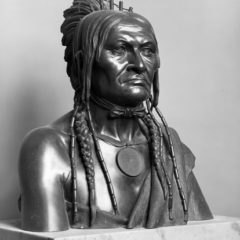
From the article, West Duluth pioneer Alfred Merritt’s reminiscences of early days at the head of the lakes:
There the rocks came out to the bay and made a lee on either side of this point of rocks, so that when the wind was from the northeast or northwest you could lay with your small boat or canoe in perfect safety. I am sure that this is the land mark chosen by Chief Buffalo at the Indian treaty at LaPoint in the fall of 1854, as the starting point, the line to run one mile north, one mile east, one mile south and one mile west back to the point of starting. This would have taken in the old burial ground at the foot of Rice’s Point.
They had this large burial ground there and as you know, the Indians are more particular than the white people about these things. The treaty was tampered with, unquestionably, by interested parties. In fact, when this land was looked up, according to the treaty papers, it was found to be located six miles out in Lake Superior.
Then I dug a little deeper and found out that 30 years ago one of the Chief’s descendants, Richard Lee Armstrong, RE-claimed his ownership of his land, and even wrote a song about it, “Landlord of Duluth.”